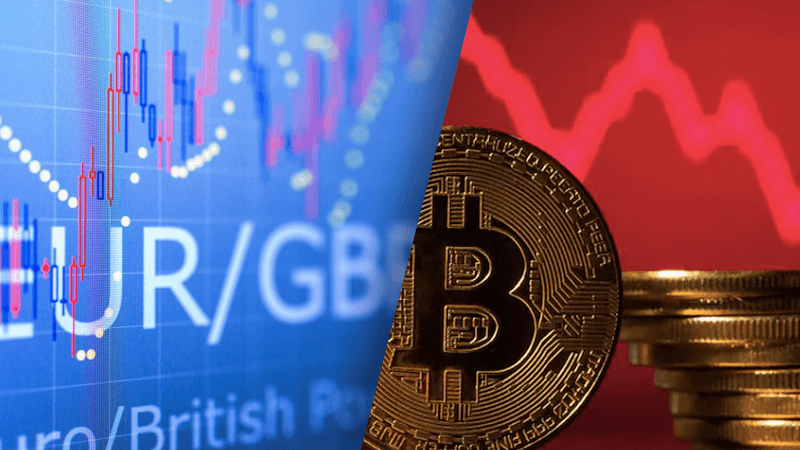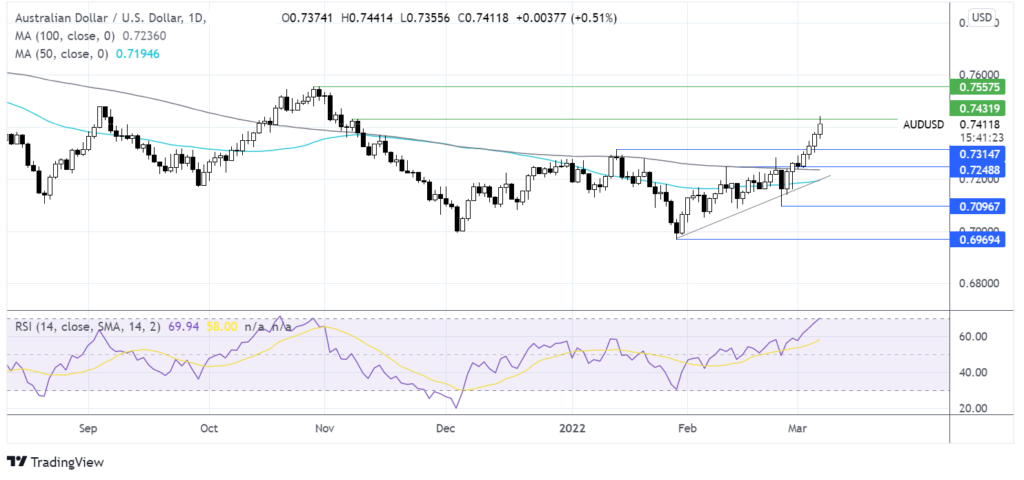Russian war boosts commodities, hits euro on stagflation fears

EUR/GBP => The pair falls below 0.8250
BTC/USD => The cryptocurrency falls below $40,000
AUD/USD => The pair rises to a 4-month high
AUDUSD rises as commodities surge higher
AUDUSD rose 1.9% last week as the Russian attack on Ukraine rippled through the financial markets. Rather than the riskier Aussie losing ground to safe havens flows, instead the Australian currency has been traced commodity prices higher. Commodities across the board have risen on supply fears as hopes of a quick resolution to the war fade and as sanctions on Russia start to bite. Prices in energy, industrial & precious metals, and soft commodities have risen. These are Australian exports, and Russia is a direct competitor with Australia in some instances. Higher prices and higher volumes of commodities are a win-win for the AUD and even boosted the currency against the USD despite a strong non-farm payroll, which supports the prospect of a rate hike in March and several more across the year. Overnight data revealed that the Australian services index rose to 60, up from 56.2. Gold trades at 1$980, a level last seen in August 2020.
| Aus. Services PMI
US Non-farm payroll |
Actual: 60 (3.8)
Actual: 678k (60k) |
Previous: 56.2
Previous: 467k |

Where next for AUD/USD?
AUDUSD is extending its recovery from 0.6970 the 2022 low hit in late January. The pair has risen above the 50 & 100 SMA before running into resistance at 0.7414 a 4-month high. The RSI has tipped into overbought territory so some consolidation could be on the cards, before further gains towards 0.7550 the October 2021 high. On the flip side, it would take a move below 0.7314 to negate the near-term uptrend, with a fall below 0.7100 the February 24 low needed to change the bias to bearish.
Bitcoin falls below $40,000
After rallying to a high of 45,300 on Tuesday, Bitcoin started to edge lower as last week progressed. BTC/USD fell over 7% on Friday, falling to 38,700, weighed down by an optimistic US non-farm payroll report and falling risk sentiment as the Russia Ukraine war intensified. Safe havens and commodities performed well while cryptocurrencies remain vulnerable to risk aversion, pushing the price back below the critical 40,0000 psychological level, which is now a key resistance and below its 50 SMA on the daily chart.
EUR/GBP falls to a 5-year low
EURGBP fell 0.3% on Friday, hitting a five-year low of 0.8228, and continues to trade around this level as the news week begins. The euro is out of favour amid fears over the impact of sanctions on Russia on the eurozone economy. Aside from Russia, Europe stands to lose significantly givens its trades links to Russia and its dependence on Russian energy. Oil prices surged to $130 overnight and gas trades at record highs prompting fears of surging inflation and weak growth of even a recession. On Friday, weaker than expected retail sales added to the downbeat mood towards the euro. Today Russia is still under the spotlight data is likely to take a back seat again. German retail sales are forecast to rebound after a very weak December. German factory orders and Eurozone investor sentiment data are also due to be released.
| EZ retail sales
German retail sales MoM |
Actual: 0.2% (1.3%)
Expected: 1.5% (7%) |
Previous: 1.5%
Previous: -5.5% |
Support can be found at 0.8231 (daily low) and 0.82 (round number).
Resistance for the pair can be seen at 0.8280 (February 3 low) and 0.83 (February 24 low).
